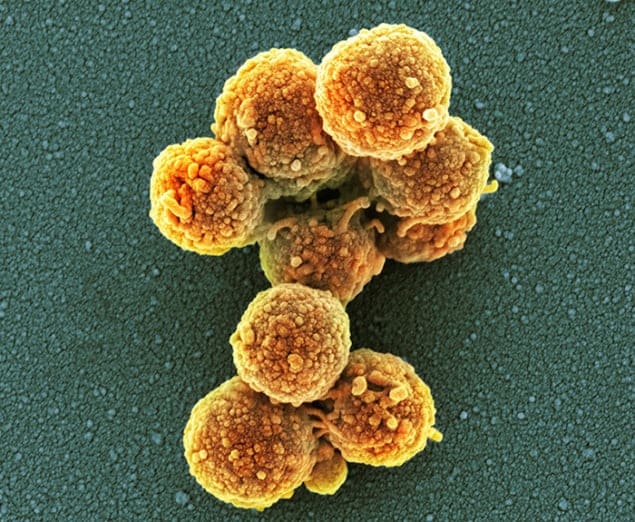
A proposal for putting a living bacterium into a superposition of quantum states has been unveiled by physicists in the US and China. If successful, the experiment would be the first realization – albeit microscopic – of Schrödinger’s famous thought experiment involving a cat in a box that is simultaneously alive and dead until an observer makes a measurement by peering into the box. As well as improving our understanding of the foundations of quantum mechanics, the researchers say that their proposed experiment could also yield a new technique for monitoring defects in biological molecules.
Superposition is a quirky property of the quantum world that allows a physical system such as an atom or photon to exist in two or more quantum states, until a measurement is made on it. In recent years, physicists have created superposition states using inanimate objects of increasing size, from electrons and photons to atoms, molecules and even tiny mechanical systems. Now, Tongcang Li of Purdue University and Zhang-Qi Yin of Tsinghua University propose doing the same thing with a living object – a tiny bacterium – to realize a version of Schrödinger’s cat.
The proposal involves a tiny mechanical oscillator built by John Teufel and colleagues at the National Institute of Standards and Technology in Colorado. That oscillator is an aluminium disc 15 μm across and 100 nm thick that forms the upper plate of a capacitor within a superconducting inductor-capacitor (LC) circuit. In 2011 Teufel’s group was able to put the mechanical oscillator in its quantum ground state. This was done by first cooling the apparatus in a cryostat and then subjecting the oscillator to “sideband cooling”, which involves coupling its mechanical vibrations to microwave radiation.
Tiny bacterium
Li and Yin asked themselves whether it would be possible to place a micro-organism in a quantum superposition by attaching it to the mechanical oscillator. The micro-organism would have to be so tiny that it would have almost no effect on the oscillator’s vibrations. They suggest that a 0.02 pg mycoplasma bacterium could be fixed to the 48 pg oscillator by the van der Waals force. The mechanical oscillator plus micro-organism would then be put in a superposition of its ground and first excited state.
The researchers explain that the superposition would originate in a superconducting quantum bit, or qubit, attached to the LC circuit, and might consist of simultaneous clockwise and anticlockwise currents. That superposition would then induce a tiny current in the LC circuit that sets up a microwave oscillation with energy about halfway between the circuit’s ground and first excited state. This would excite the mechanical oscillator to vibrate simultaneously in the ground and first excited states, and create a vibration-based superposition of the organism.
Many micro-organisms can be preserved for several years at cryogenic temperature without losing their viability
Tongcang Li, Purdue University
Yin told physicsworld.com that the main challenge in carrying out such an experiment will be bringing together scientists that have experience of both high-quality mechanical oscillators and superconducting resonators and qubits. But in future, once the experiment is realized, he says, the technique may help to test the validity of different interpretations of quantum mechanics.
Finding free radicals
The researchers also describe a second experiment that could be carried out with the same apparatus. This would involve scanning a ferromagnetic tip mounted on a rigid cantilever above the micro-organism, to entangle the overall motion of the bacterium with electron spins inside it. Because those spins could belong to the extra electrons that exist inside free radicals, this kind of measurement might allow defective DNA or proteins to be identified within biological samples, says Yin. The approach might also allow isolated electron spins, which cannot be read out using optical or electrical techniques, to be used as quantum memory, he adds.
The latest research is not without precedent. In 2009 Oriol Romero-Isart, then at the Max Planck Institute for Quantum Optics near Munich in Germany, and colleagues proposed placing nanoscale dielectric objects, including micro-organisms such as viruses, into quantum superpositions by optically levitating and cooling their centre-of-mass motion to micro-kelvin temperatures inside optical cavities in a vacuum. But Yin says that the lasers used to hold the objects in place would heat those objects up, perhaps to the point where viruses lose quantum coherence. The new scheme, in contrast, involves cooling a bacterium’s internal temperature down to around 10 mK, at which point the organisms should be frozen solid. With negligible chemical activity taking place inside them, and negligible amounts of energy exchanged with the surroundings, the delicate quantum state of the oscillator plus bacterium should be preserved for significant lengths of time – up to around a millisecond – explains Yin.
The need to cool the bacterium to just a hundredth of a degree above absolute zero invites an obvious question – would such an experiment really be demonstrating the quantum superposition of a living organism? Li believes it would. He says that the frozen mycoplasma bacterium would still be alive in the sense that it would become active again after being thawed. Indeed, he notes that “many micro-organisms can be preserved for several years at cryogenic temperature without losing their viability”. But he does acknowledge that the use of active bacteria would lead to more interesting experiments. “We will leave the possibility of creating superposition states of an active micro-organism for future studies,” he adds.
The research is reported on the arXiv preprint server.



